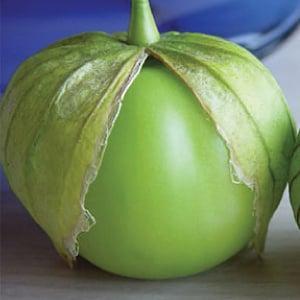
Learning Download: How to Grow Tomatillos
From Seed to Harvest: A guide to growing tomatillos.
Tomatillos are an ingredient often present in Mexican dishes, and the fruit is grown similarly to a tomato. Tomatillos differs from green tomatoes as they are usually juicier and not as firm. Though commonly used in sauces and salsa, tomatillos can be used in appetizers, desserts and jams as well. Tomatillos also are known as a husk tomato, due to the papery husk covering the fruit.
To plant:
Two or more tomatillo plants are required for the plants to blossom. Wait until all danger of frost has passed before planting the tomatillos outside. Since tomatillos have a long growing season, they can be started indoors up to eight weeks before the last frost date. Plant seeds 1/4 inch deep and space seedling 18-24 inches apart in rows set 3 to 4 feet apart when transplanting. Tomatillos also grow well in pots and can be planted in 5-gallon buckets.
To grow:
Tomatillos grow similar to a tomato. Tomatillos grow similar to a tomato. They like full sun and frequent watering. Adding a layer of mulch around the plants can help deter weeds and retain moisture. They also require staking or cages to support the plant and keep the fruits off the ground. If the plant isn’t staked and fruits weigh the plant down, slugs or snails are more apt to feast on the tomatillos. Tomatillos do best in soil with a pH of 6.0 to 7.0. Tomatillos cannot withstand frost, so if a late spring frost is forecasted, be sure to cover the seedlings with newspaper.
To harvest:
Tomatillos are ready to harvest when the green fruit fills out the papery husk. Similar to tomatoes, they can be harvested early and then left in a sunny window to further ripen. Before using the tomatillos after harvest, keep the husks on as this lengthens storage time. When you remove the husks, also wash the sticky substance from the tomatillo’s flesh.
What tomatillos crave:
Tomatillos are a plant with high yields and adding a fertilizer can aid in the plant’s growth. Prior to planting, amend the soil with compost or a 10-10-10 fertilizer and work it several inches deep into the soil. Fertilize again when the first flowers begin to appear, this time using a 5-10-10 fertilizer. This encourages more flowers and fruit production. Over fertilizing can lead to leafy plants with little fruit, so be sure to follow the directions on the fertilizer when it comes to application.
Studying the leaves of the tomatillo plant can show if it has any deficiencies. Leaves with a purple tint have a phosphorous deficiency and yellowing leaves mean there could be a magnesium deficiency. Fertilizers high in potassium and phosphorous can lead to high fruit yields.
Where to buy tomatillo seeds:
You can find tomatillo seeds at Urban Farmer.
Learning Download: Common pests and diseases: Tomatillos
Common pests and diseases: Tomatillos
When growing vegetables, it is always exciting to care for the plant throughout its growing phase and then harvest it for delicious recipes later on, but one thing to watch out for is pests and diseases. Different plants are susceptible to different types of pests and diseases, and it is important to make yourself aware so you can keep a watchful eye and also take any preventative methods to keep your plants safe throughout their lifespan.
Tomatillos can fall victim to several different pests and diseases.
Pests:
The most common pests affecting tomatillos include aphids, cutworms and slugs.
Aphids are soft-bodied insects that bring problems to lots of plants. They create discoloration of the leaves, necrotic spots and stunted growth. Use tolerant varieties and only apply insecticides if there’s a high infestation.
Cutworms will cause the stems of young plants to be severed at the soil line, and irregular-shaped holes may be eaten into the surface of the tomatillos. To prevent cutworms from infesting your plants, remove all crop debris from the soil after harvest, apply stem collars covering the stems for at least 3 inches above the soil line and apply pesticides when needed.
Slugs will leave large holes in foliage or even consume the leaves in their entirety. They will leave a slime trail and typically will feed at night. Slugs are usually more of a problem in damp weather. Handpick the slugs from the tomatillos, or use a trap of cornmeal or beer.
Diseases:
Tomatillos can fall victim to several different diseases, including anthracnose, bacterial leaf spot, root knot nematodes and more.
Anthracnose causes circular lesions on the fruit, and sometimes these lesions can expand to cover the entire fruit’s surface. Plant disease-free seed and treat seeds with hot water prior to planting. Practice crop rotation and make sure you plow all crop debris into the soil after harvest to help prevent inoculum in the soil. Anthracnose is found in most vegetable-growing areas and can cause large losses to crops if untreated.
Bacterial leaf spot will cause translucent spots with yellow edges that will slowly become larger. This disease does better in cooler temperatures, and it can disfigure the flower heads. When the spots enlarge, they may become irregularly circular with a red-like center. Remove the infected plants and practice good crop rotation. Also, try to avoid overhead watering.
Root knot nematodes are microscopic pests that cause galls, or swelling, to form on the roots. Plants will wilt, or they may appear stunted. Typically, this problem is more frequently-occuring in southern states. To manage this disease, don’t plant the tomatillos into infected soil. You can also try planting varieties of Nema-Gone marigolds around your tomatillo plants to prevent this.

